Chapter 3 The Scientific Landscape
In this section we examine the scientific landscape for research involving marine species. In total we identified 6,659 scientific publications in Clarivate Analytics Web of Science Core Collection that contained a marine species listed in the World Register of Marine Species (WoRMS) database. Approximately 17,736 researchers were engaged in research on marine species and ASEAN researchers were co-authors on 77% (5,109) of the publications. The 6,659 records contained 3,685 marine species after the exclusion of common model organisms.
Figure 3.1 displays a snapshot overview of activity for marine species in the region.
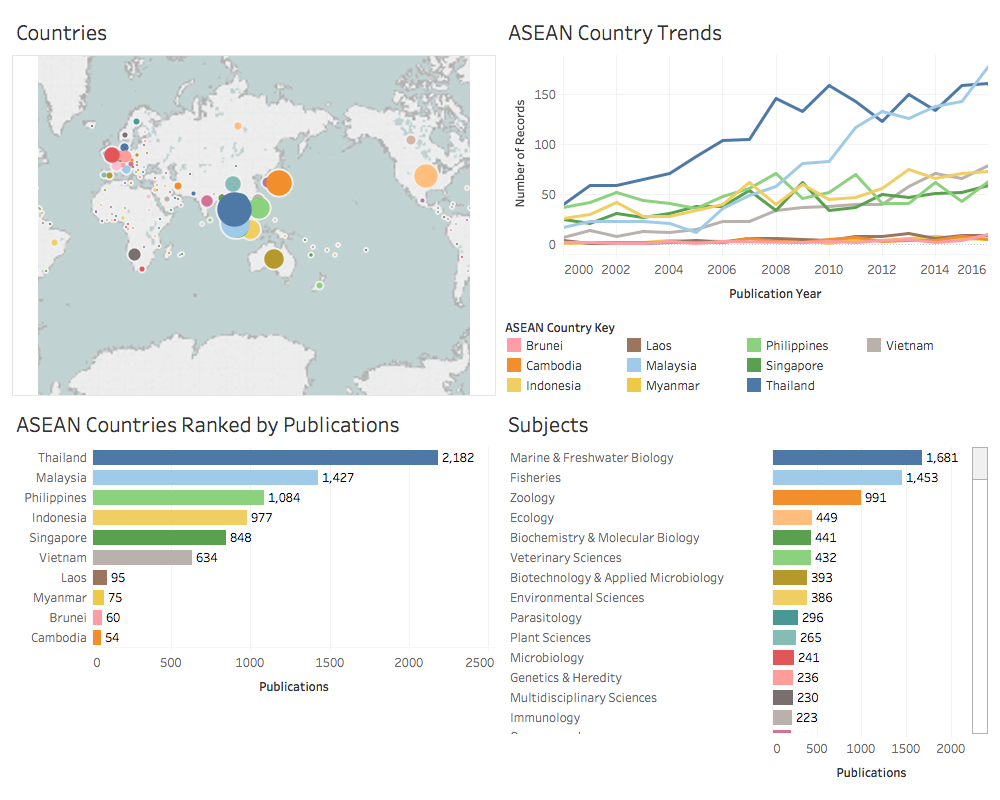
Figure 3.1: Overview of Research Activity for Marine Species in ASEAN countries
In Figure 3.1 we can immediately see that marine research in the ASEAN region encompasses countries within and outside the region. This reflects the increasingly international nature of modern scientific research and marine research. We can also observe significant variation in levels of marine publications between ASEAN countries with respect to trends that reflect the underlying emphasis and strength of each country with respect to marine research. Finally, information on the subject area of research reveals the prominence of Marine & Freshwater Biology (as we would expect) along with more applied fields such as Biotechnology & Applied Microbiology and Parasitology or Immunology that provide an indication of potentially more commercially oriented research areas.5
3.0.1 Trends by Country
The presentation of trends by country in Figure 3.1 has the effect of pressing countries with lower level marine research outputs to the bottom of the graph. We gain a clearer view of country level trends in Figure 3.2 where the data for each country is presented in separate panels. In Figure 3.2 we present the data as a scatterplot and then add a smoothed trend line (using Loess or locally weighted smoothing) between the data points.
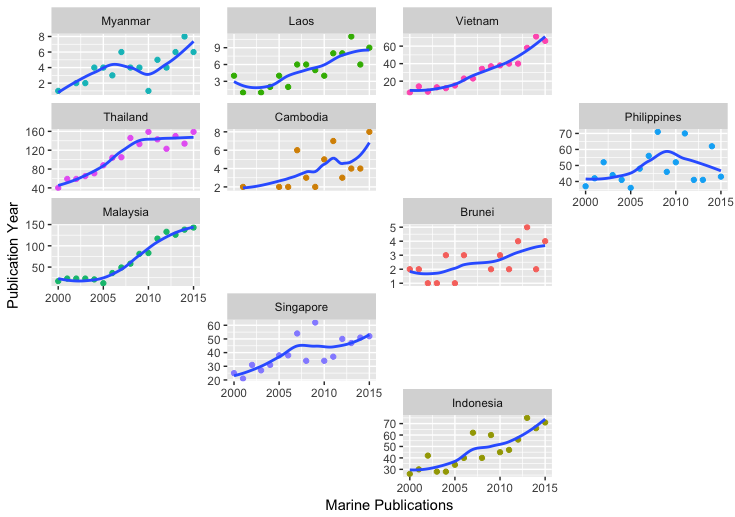
Figure 3.2: Country Trends for Research on Marine Genetic Resources in the South East Asia Region
This reveals, that in general all countries within the region have displayed an increase in publications on marine research over time with Myanmar, Laos, Cambodia and Brunei exhibiting less than 10 publications per year across all years. For countries with higher levels of activity, Thailand emerges as the leading country for research involving marine species. However, research outputs plateaued from 2010 onwards before staging a more recent increase in 2016. In the meantime, as can more clearly be seen in Figure 3.2, Malaysia has displayed a steeply rising trend in research outputs that has overtaken Thailand. In contrast with countries throughout the region that display a rising trend, the Philippines displays a declining trend from approximately 2008 onwards that may reflect either a change in the orientation or research outputs (for example with a more applied focus that place less emphasis on publications) or a decline in research investment in marine research.
Research outputs, in the form of peer reviewed research articles and scientific publications, reflect underlying investments and incentives for scientific research in the marine and terrestrial aquatic environments. As we have seen, while varying in intensity, in the majority of ASEAN countries marine organisms are an increasing or emerging focus of scientific publications. We now take a closer look at the nature of research activity.
3.0.2 Marine Species Research
Figure 3.3 presents an overview of marine research in the ASEAN region from the perspective of the species that are a focus of research. For the top ten species we provide a set of short fact sheets in Chapter 6 of the report. Here we present a short summary for the top species.
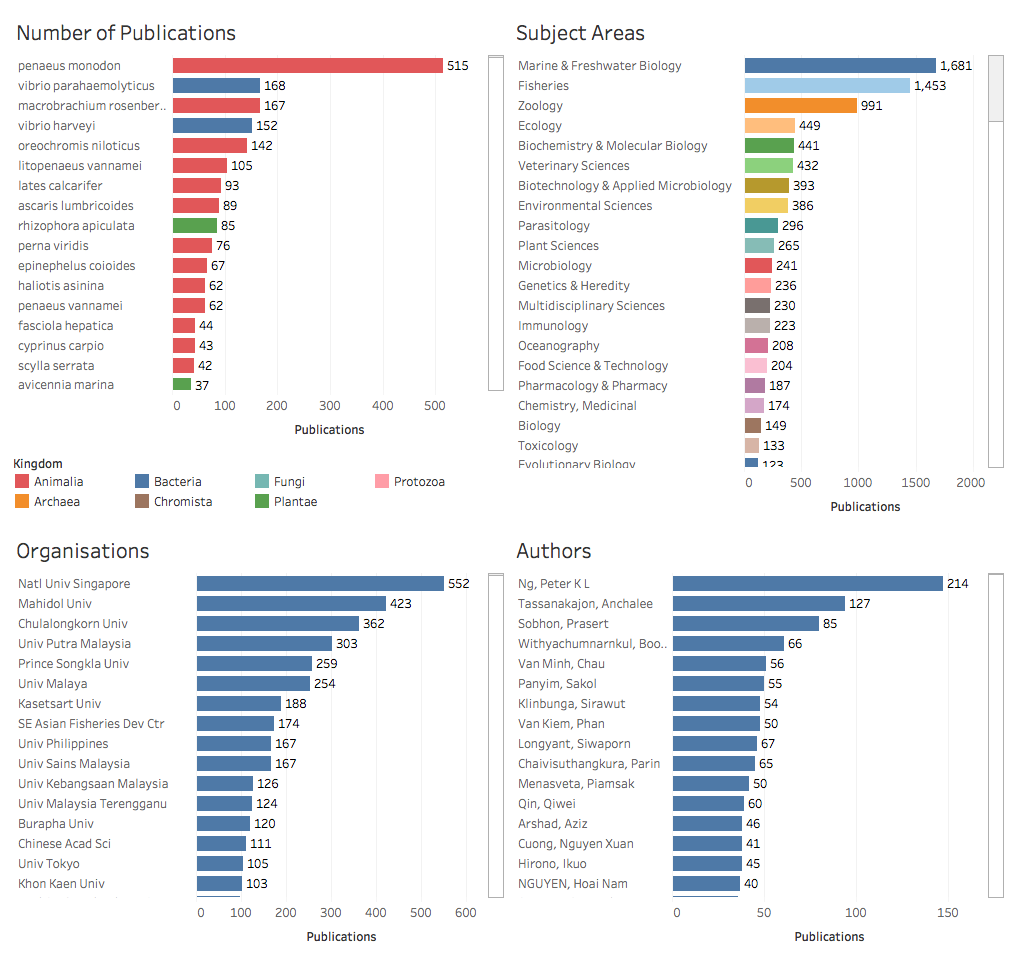
Figure 3.3: Top Marine Species Overview
In considering Figure 3.3 a number of the top species are shrimps associated with the rapid growth of aquaculture in the region from the late 1990s onwards (Hishamunda et al. 2009).
Figure 3.3 reveals that the species that the Giant Tiger Shrimp (Peneaus Mondon) is a major focus of research activity that reflects the economic importance of the species in the aquaculture sector within the ASEAN region. Research with respect to Peneaus Mondon is directed towards maximizing yields. A significant proportion of the literature focuses on understanding P. mondon immune responses to viral and bacterial pathogens that are responsible for large scale mortality in tiger shrimps, notably White Spot Syndrome Virus, Yellow Head Virus and Vibrio harveyi (Wongteerasupaya et al. 1995; Ponprateep, Tassanakajon, and Rimphanitchayakit 2011; Jaree, Tassanakajon, and Somboonwiwat 2012).
The second ranking animal species in the data also relates to aquaculture. Macrobrachium rosenbergii (the Giant River Prawn and the Giant Freshwater Prawn) is widely fished and is the main freshwater shrimp cultivated within the commercial aquaculture industry (De Grave, Shy, and Wowor 2012).6 While this is a freshwater species, females move into brackish estuarine waters to lay their eggs. As with P. mondon research is directed towards maximizing yields and reducing mortality from pathogens such as White Tail Disease virus (Bonami and Widada 2011). Improvements to broodstock genetics (Karaket and Poompuang 2012; Thanh et al. 2015, 2010) as well as improvements to prawn feed (Kangpanich et al. 2016) have been a significant focus of research activity.
Oreochromis niloticus is a species of Tilapia, a cichlid fish native to the Nile basin in Africa and coastal rivers of Israel.7 It is an economically important species introduced into the ASEAN region and elsewhere because it is fast growing. The literature focuses on issues such as genetic improvement (Bentsen et al. 1998), options for rice paddy field polyculture in conjunction with other species (Vromant, Nam, and Ollevier 2002) , and salt tolerant hybrids for aquaculture in coastal ponds for this freshwater species (Kamal and Mair 2005).
Litopenaeus vannamei is the world’s dominant cultivated shrimp. It grows as a juvenile in estuarine environments and lives in marine salt water as an adult. South East Asia has witnessed dramatic growth in aquaculture for this species, notably in Thailand and China. Improving breeding stocks (Nimrat et al. 2006), protection against infectious myonecrosis (Silva et al. 2010), and alternatives to the use of antibiotics such as the use of probiotics (Nimrat, Boonthai, and Vuthiphandchai 2011) feature prominently in the literature for this major species.
Lates calcarifer is the Barramundi or Asian seabass and is a widely distributed demersal fish ranging from the Persian Gulf through South East Asia and Papua New Guinea.8 It is typically found in estuaries, coastal waters, lagoons and rivers. Research has focused on aquaculture for this species including understanding the natural history of the species (Shadrin and Pavlov 2015) and fish feed (Shansudin et al. 1997; Mohd-Yusof et al. 2010) including the use of local seaweed species (Shapawi and Zamry 2015).
Ascaris lumbricoides is the large roundworm and is responsible for causing ascariasis in humans. While A. lumbricoides is aquatic and recorded by WoRMS as a marine species it is excluded from further analysis because the focus of the scientific literature in the ASEAN region is on soil transmitted helminth infections in humans, including in coastal areas, rather than the marine environment as such (Montresor et al. 2007).
Perna viridis is commonly known as the Indian Green Mussel. Research in relation to this species in ASEAN countries focuses on issues such as the impacts of metal concentrations, notably heavy metals on speciation, the implications of contamination for human health and the potential use of the species for wider biomonitoring of heavy metal contamination (Yap et al. 2002, 2003; Yap, Ismail, and Tan 2004). Other research addresses concentrations of shellfish toxins and Vibrio parahaemolyticus in P. viridis (Marasigan et al. 2001) along with issues such as suspension feeding behaviour (Hawkins et al. 1998; Tan and Ransangan 2016) and genetic diversity (Ye, Li, and Wu 2015). As this suggests, land based run offs of contaminants into the marine environment in the ASEAN region has become a significant focus of research for this economically important species.
Epinephelus coioides is the Orange Spotted Grouper or Estuary Cod. This is an IUCN Red List near threatened species that in its juvenile stage is found in estuaries and mangroves and as adults in brackish water and coastal reefs.9 It is a commercially important species including in aquaculture. Research in the ASEAN region has included work on cell lines (Qin et al. 2006), feeding performance (Doi et al. 1997; Eusebio, Coloso, and Mamauag 2004) and the immune system of this important commercial species (Zhou et al. 2011; Guo et al. 2012).
Two bacteria feature prominently in marine research in the ASEAN region. The first of these is Vibrio parahaemolyticus, a gram negative bacteria that is found in estuarine, coastal and marine waters. Vibrio parahaemolyticus is now a globally distributed species associated with vibriosis through the consumption of raw shellfish or exposure to contaminated water (Nair et al. 2007). Within the literature for ASEAN countries the main focus is on the impact of contamination in aquaculture, including detecting strains associated with infection(Rahman et al. 2006) and vaccines (Hu and Sun 2011). The risks of mortality in shellfish stocks and consequent mortality rates are combined with increasing awareness of the problem of antibiotic resistance and the quest for alternatives such as botanical extracts sourced from ASEAN countries (Sivasothy et al. 2013; H. Nguyen et al. 2016; Tinh et al. 2016).
The second major bacterial species is Vibrio harveyi, a Gram-negative, bioluminescent and common marine bacterium in the same genus as V. parahaemolyticus. It is common in the gut of many tropical marine organisms with a small number of strains being pathogenic. While the bacteria is normally benign, pathogenic sub-strains are particularly associated with impacts on shrimps such as P. mondon, with the ASEAN literature focusing on detection and the use of natural compounds, including from marine cyanobacteria (Ponprateep, Somboonwiwat, and Tassanakajon 2009; Maneechote et al. 2016)
Rhizophora apiculata is a widespread intertidal mangrove species in the ASEAN region. The species is used for firewood and is also a focus of commercial mangrove silviculture in the region (Duke, Kathiresan, Salmo III, Fernando, et al. 2008a). A second important mangrove species is Avicennia marina, known as the grey or white mangrove that is widely distributed throughout the ASEAN region and beyond. It takes form as a shrub or tree and has a range of uses as a food source, in construction and medicine (Duke, Kathiresan, Salmo III, Fernando, et al. 2008b). Research on this species in the ASEAN region has focused on issues such as genetic structure and variation (Arnaud-Haond et al. 2006; Giang et al. 2003), the impacts of aquaculture water on mangroves (Vaiphasa et al. 2007), biodiversity (Zhila, Mahmood, and Rozainah 2013), mangrove restoration (Aung et al. 2011) and new plant extract for alopecia treatment (Jain et al. 2015, 2014).
As this brief summary of the major species suggests, the marine data is dominated by species that are commercially important in aquaculture within the region. This comes into clearer focus if we examine the relationship between research on species grouped on the genus level and the subject areas of publications.
Figure 3.4 presents a Sankey diagram of the flow between research on the species and Subject Areas presented in 3.3. A Sankey diagram is typically used to display the flow of energy, in this case investments in research on species grouped on the genus level, and the intended audiences represented by the subject areas.
We can clearly see in Figure 3.4 that research on Penaeus (e.g. Tiger Prawn) genus primarily flows into fisheries followed by Marine and Freshwater Biology. The link between research on Penaeus and Vibrio is represented by Immunology and Veterinary Science. In contrast work on mangroves (represented by Avicennia and Rhizophora) is more concentrated in Environmental Sciences (for Avicennia) and additionally Marine and Freshwater Biology, Ecology and Plant Sciences for Rhizophora. This suggests a more basic research orientation for our mangrove species as discussed above.
Figure 3.4: Flows of Publications on Species into Subject Areas
Figure 3.4 provides the first indication that marine research may be directed in multiple directions, from basic taxonomic and ecological research, to commercially oriented research that focuses on enhancing productivity and addressing problems such as pathogens for commercially valuable species.
In practice, research on species takes place in networks that can be explored on multiple levels.
First, researchers are typically performing research on more than one species. For example, work on pathogens of P. mondon and other shellfish will include reference both to the source species (P. mondon) and the target species.
Second, there has been a growing trend towards the internationalisation of research collaborations represented by collaborations between researchers outside their home countries and regions. This is typically supported by national research institutions, such as research councils, and home institutions administering funds on behalf of national organisations. These investments form a network of collaboration between countries that are underpinned by financial investments in research, typically by national research councils or their equivalent.
Third, collaboration networks between researchers involve inter-institutional relationships including flows of research funding, equipment, students and post-doctoral researchers.
Finally, there are the networks of relationships between researchers who build the wider inter-institutional network and communities of researchers working on particular marine species and particular problems.
To gain a fuller understanding of the characteristics of research on marine genetic resources in the ASEAN region we will explore each of these networks in turn.
3.0.3 The Species Network
Figure 3.5 displays the network relationships between publications involving marine species where there are more than 10 publications referencing the species. The dots represent nodes in the network and are sized based on the number of records. The lines or edges are based on the number of publications where the species appear in the same publication with thickness representing the number of shared links. The colours in this case refer to the kingdom for each organism as in Figure 3.3.
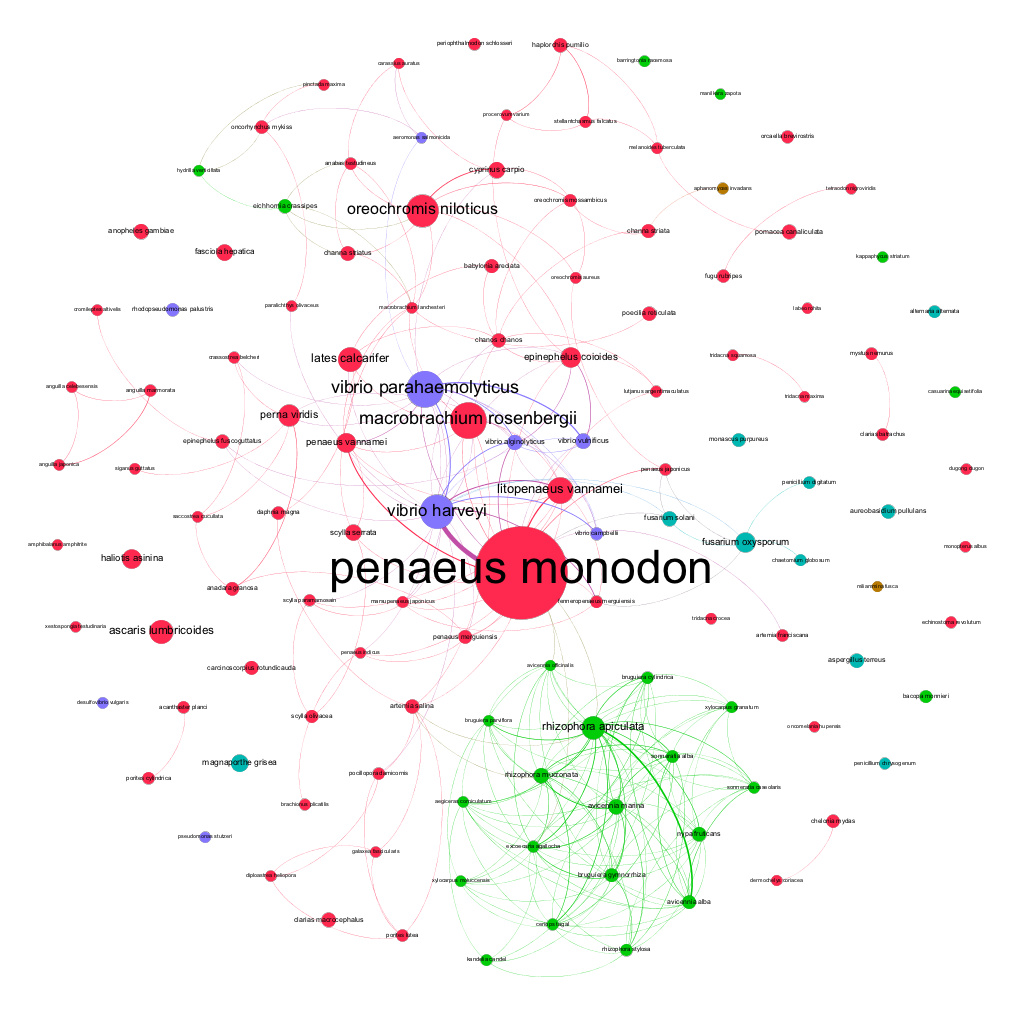
Figure 3.5: Network of Species that are the Focus of Research
What is powerful about this form of visualisation is that we can immediately see that a strong relationship between the Vibrio pathogenic viruses and important aquaculture species, notably prawns and shrimps such as Penaeus mondon, Macrobrachium rosenbergii and Litopenaeus vannamei among others such as Penaeus vannamei. We can also see that research on plants, dominated by mangroves (in green) forms a distinctive cluster of research but also links through Avicennia marina and Rhizophora apiculata to research on Peneaus mondon and related species (Hai and Yakupitiyage 2005).
We can apply this same approach to a broader overview of the scientific landscape for marine research at the level of the analysis of international and regional level research collaborations to which we now turn.
3.0.4 Country Networks
In total 136 countries appeared in the ASEAN data for research involving marine genetic resources (see Figure 3.1 above). Collaborations between countries involved in marine research can be visualized as a network. Figure 3.1 below displays the country collaboration network where there are two or more publications involving researchers from those countries. Once again the size of the nodes reflects the number of publications.
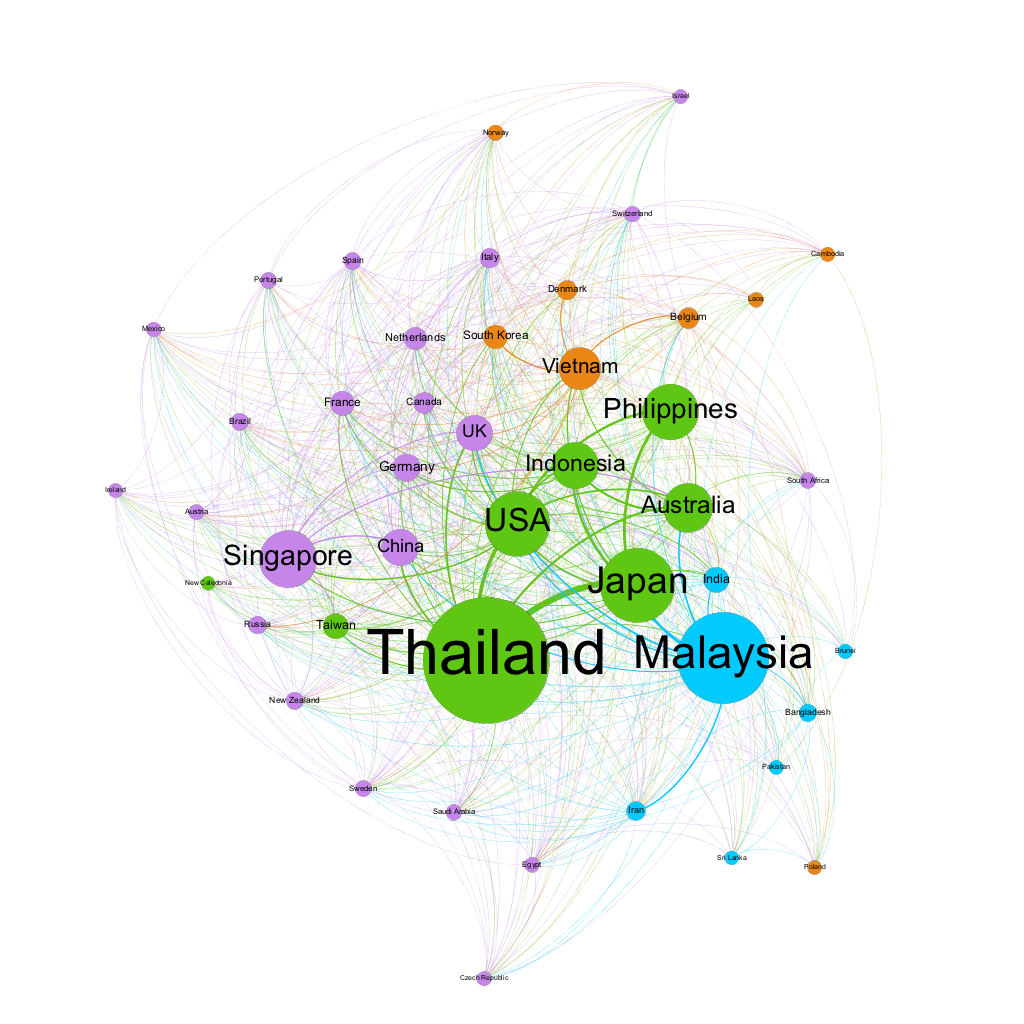
Figure 3.6: Country Collaboration Networks for Marine Genetic Research in the ASEAN region
In Figure 3.6 the country nodes are sized based on the number of records that involve a publication with an author from the country. The lines (edges) represent publications by authors from both countries with the weight of the lines indicating the number of publications. The colours denote communities of collaborating countries based on the calculation of the strength of the links between them compared with the strength of connections between all other nodes (countries) (Blondel et al. 2008). This allows us to see the distinctive network connections between ASEAN countries and other countries.
Figure 3.6 reveals 4 main country network clusters. The largest network cluster is represented by Thailand with strong connections with Japan, the United States, Australia, the UK and China along with the Philippines. Malaysia displays weaker links with a number of these countries but is distinctive for its links with India, neighbouring Brunei, Bangladesh, Pakistan and Sri Lanka. Singapore displays a weaker but wider set of connections with other countries, while Vietnam forms part of a network with South Korea, Denmark, Norway, Laos and Cambodia. The importance of mapping these collaboration networks is that they reflect underlying financial investments in the form of research funding, investments in student training, equipment and materials.
3.0.5 The Funding Network
This network of relationships between countries reflects underlying national investments in the driving force behind all research: research funding. Data on research funding is difficult to access and has only been available in Web of Science from 2008 onwards and suffers from a lack of uniformity in the data requiring extensive cleaning. However, we can gain a partial insight into the major funding agencies involved in marine genetic resources in the ASEAN region in the network map in Figure 3.7. This network displays funding organisations that appear in the acknowledgements of more than 20 publications in the ASEAN Web of Science dataset.
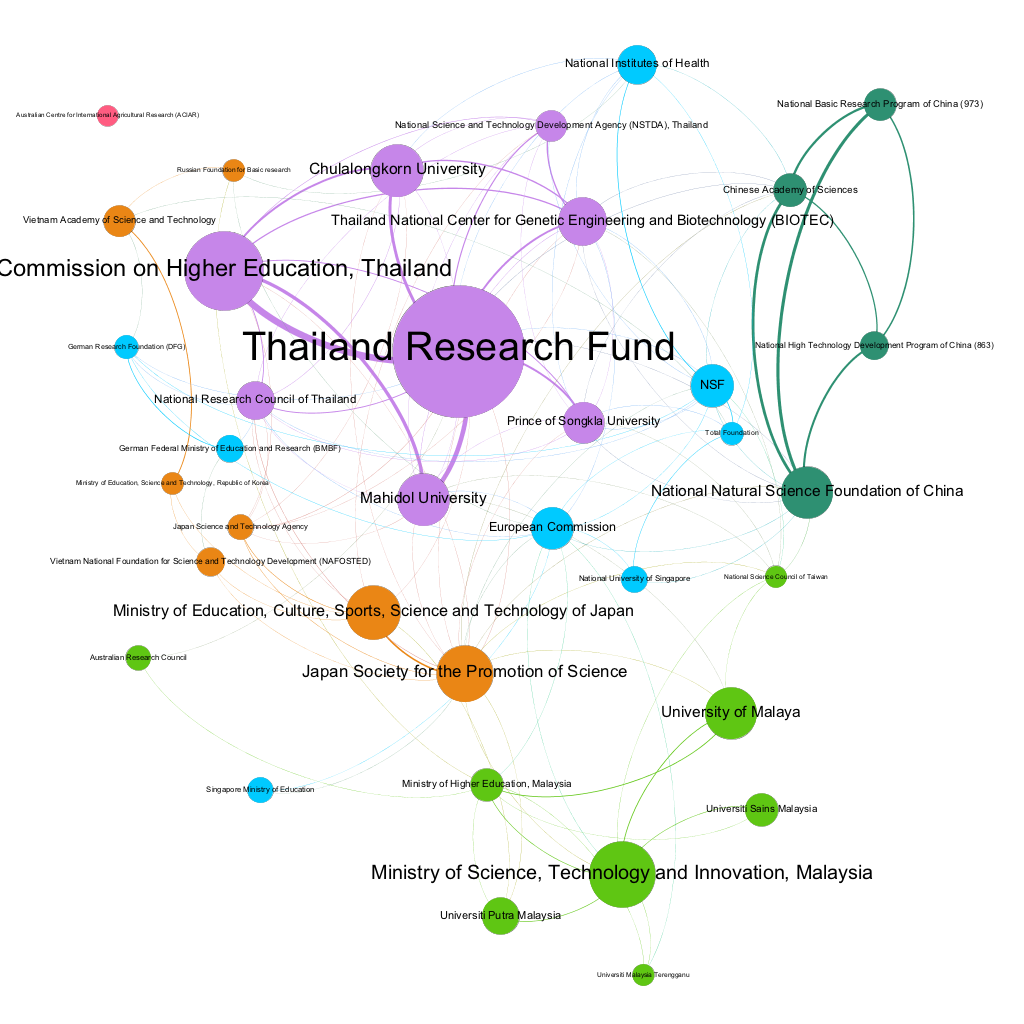
Figure 3.7: Major Funding Networks for Marine Genetic Research in the ASEAN region
In considering Figure 3.7 we immediately observe the dominant position of the Thailand Research Fund and the Commission on Higher Education in Thailand (officially the Office of the Higher Education Commission or OHEC) along with universities in funding marine research in Thailand. While this network displays rankings based on the number of publications, rather than the size of investments, it suggests that the strong trend in publications in marine research in Thailand reflects dedicated funding investment. Looking outside Thailand, a network of external funding bodies emerges in connection with publications from Thailand in the form of the United States National Science Foundation (through the Thailand National Research Fund and the BIOTEC centre) as well as joint publications with research funding from Germany. Funding Agencies from Japan appear particularly prominently in the funding network notably through the Ministry of Education, Culture, Sports, Science and Technology (MEXT) and the Japan Society for the Promotion of Science. Funding organisations from China are also emerging as a major funding source on marine research publications.
As noted above, our ability to view funding networks is presently partial. However, we can also gain an insight into the subject areas where research investments are being made. Figure 3.8 aggregates the funding agencies by country and displays the subject areas of research outputs focusing on the top subject areas.
Figure 3.8: Funding Flows through Publications on Marine Genetic Resources in the ASEAN region
Three points stand out in Figure 3.8. The first of these is a clear investment stream in fisheries research in the case of Thailand that is also strong in the case of Marine & Freshwater Biology. The second point is the that Vietnam’s research investment is marked by an emphasis in Chemistry and Pharmacology (as are research investments from Korea). Investment by Japan is more evenly balanced but also includes Chemistry and Pharmacology while investments from the European Union (through the European Commission programmes) are focused on Fisheries, Marine & Freshwater Biology and Zoology. While we must emphasise that our ability to view the data is partial, and constrained by data variability, we can nevertheless detect the main orientations of research investments as we will see in more detail below.
3.0.6 The Organisational Landscape
Collaborative research relationships between countries in marine research reflect underlying collaborations between individual researchers and research teams based in organisations. In total, approximately 3895 organisations were involved in marine research linked to the ASEAN region. Advances in the availability of geomapping tools, in this case the Google Maps API, made it possible to geocode the nearly 4,000 organisations involved in marine genetic research. Figure 3.9 displays the results along with a selection of linked records from the National University of Singapore.
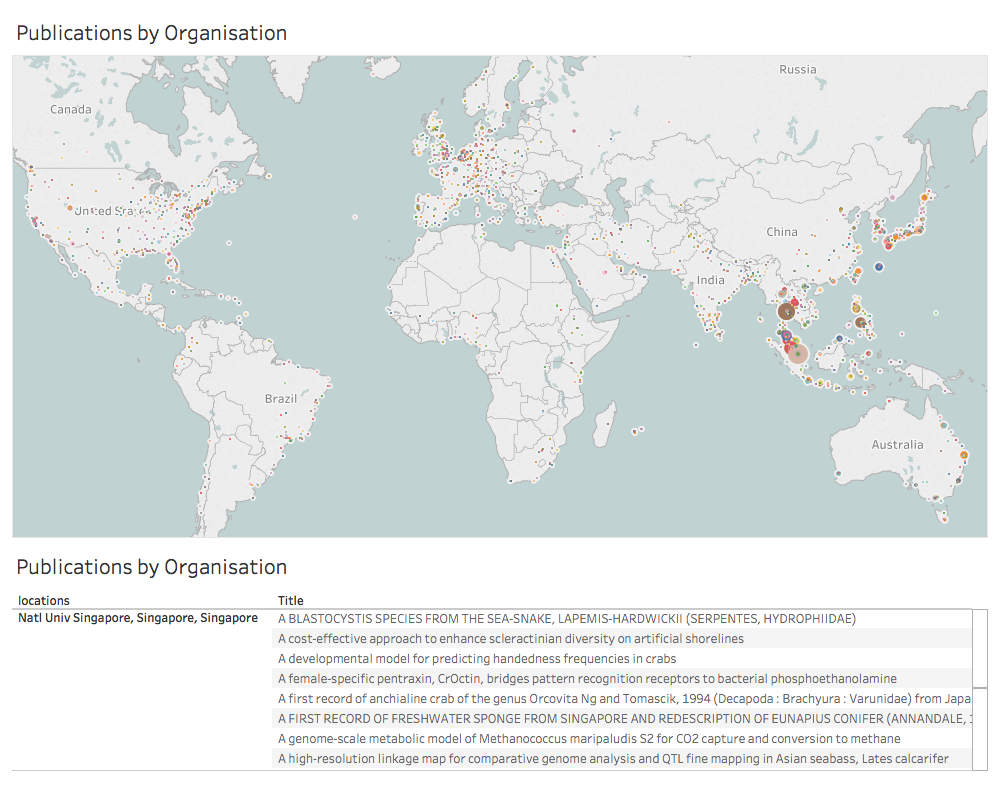
Figure 3.9: Geographic Distribution of Organisations Publishing on Marine Genetic Resources in the ASEAN Region
Figure 3.9 reveals, as we might expect, that the major clusters of research activity is found within the ASEAN region extending through to Japan, Australia and China. However, we can also observe a wider set of connections including with India, Africa, Europe and the United States that make clear the global nature of research on the marine environment in the ASEAN region.
As with the country networks, this data can also be visualised as a network. Figure 3.10 displays the network of collaborating organisations for organisations with 20 or more publications involving marine species. The nodes in the network are sized on the number of publications associated with the organisation. The lines represent the connections (in the form of co-authored articles) between the organisations with heavier lines representing stronger collaborative links. Finally colours seek to identify communities based on the strength of the co-author linkages between the actors in the network using the modularity class algorithm in Gephi for community detection (Blondel et al. 2008). This suggests that researchers at the National University of Singapore lead a networked community of researchers involving Nanyang Technology University in Singapore, the Chinese Academy of Sciences and the University of Queensland (Australia) among others. In contrast, Mahidol University, Chulalongkorn University and Prince Songkla University in Thailand are all prominent in conducting research involving marine genetic resources but have stronger links with Tokyo University of Marine Science and Technology, Deakin University (USA) and the University of California at Davis (USA). For the Philippines, a strong connection emerges with the University of Tokyo. For Vietnam, which appears on the outer edges of the network a relationship emerges between the Vietnam Academy of Science and Technology and the Russian Academy of Sciences with other links in the Vietnam community to Seoul National University and Gyeongsang National University in South Korea.
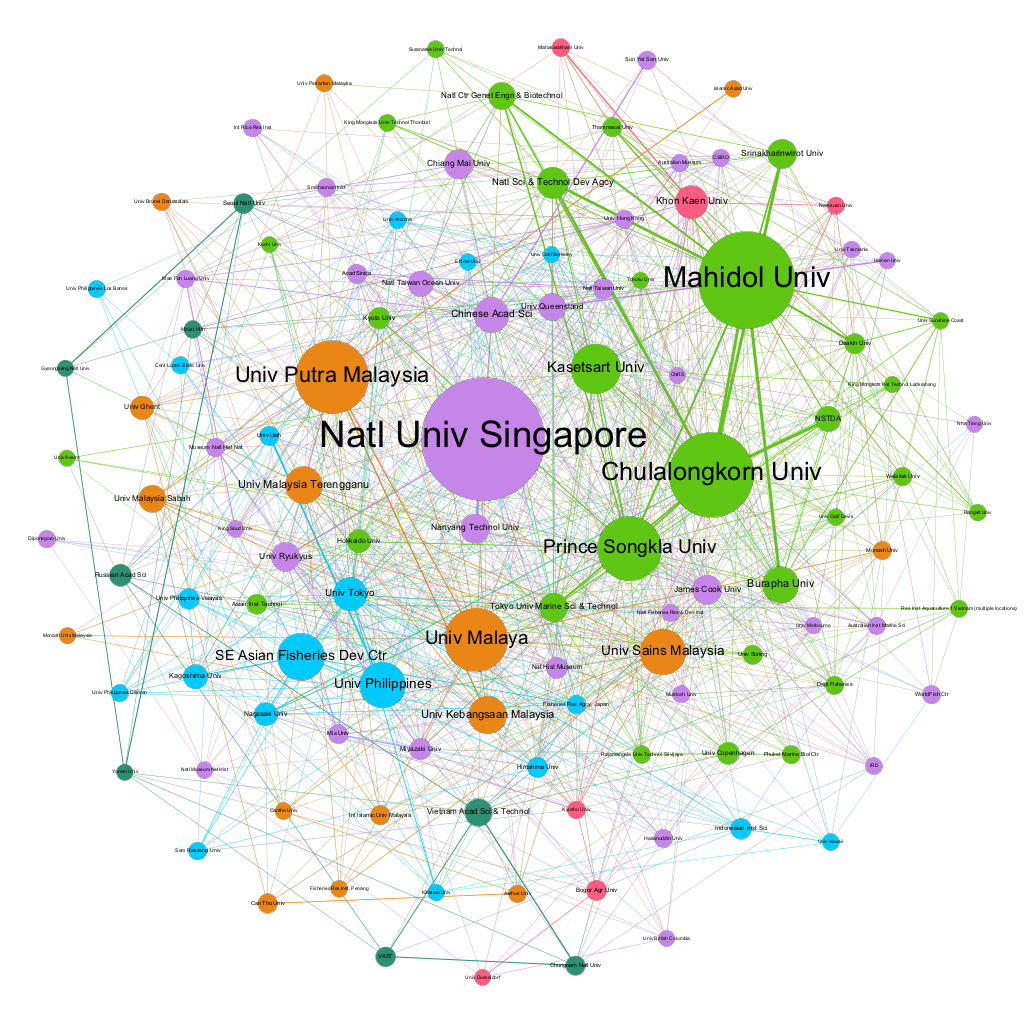
Figure 3.10: Collaboration Networks for Organisations publishing on Marine Genetic Resources in the ASEAN region based on shared publications
These networks are revealed through the analysis of the institutional affiliation of authors, but they are generally hidden networks in so far that only the parts of a network that a researcher is involved with will be visible to them while institutional knowledge of these connections may be limited. However, these networks are important in so far that they represent exchanges and transfers of knowledge, the joint generation of new knowledge and financial investments in personnel and research in the form of research funding. One question, to which we will return in the analysis of the patent data, is the extent to which organisations involved in research networks on marine genetic resources in the ASEAN region are also involved in patent activity.
We can perform a similar analysis for the researchers whose collaborations establish these networks. Figure 3.11 visualises the network of authors with 20 or more publications involving marine organisms and uses a community detection algorithm to identify clusters of collaborating authors. We will return to this analysis in more detail in consideration of the patent data. However, for the moment we observe the prominence of Anchalee Tassanakajon at Chulalongkorn University in Thailand who has conducted extensive research on the tiger shrimp (Penaeaus mondon) and on the outer edge of the network Nobel Prize winner Sydney Brenner who has collaborated with Byrappa Venkatesh from the Institute for Molecular & Cell Biology in Singapore in ground breaking research on the puffer fish genome (Fugu rubripes) (Brenner et al. 1993).
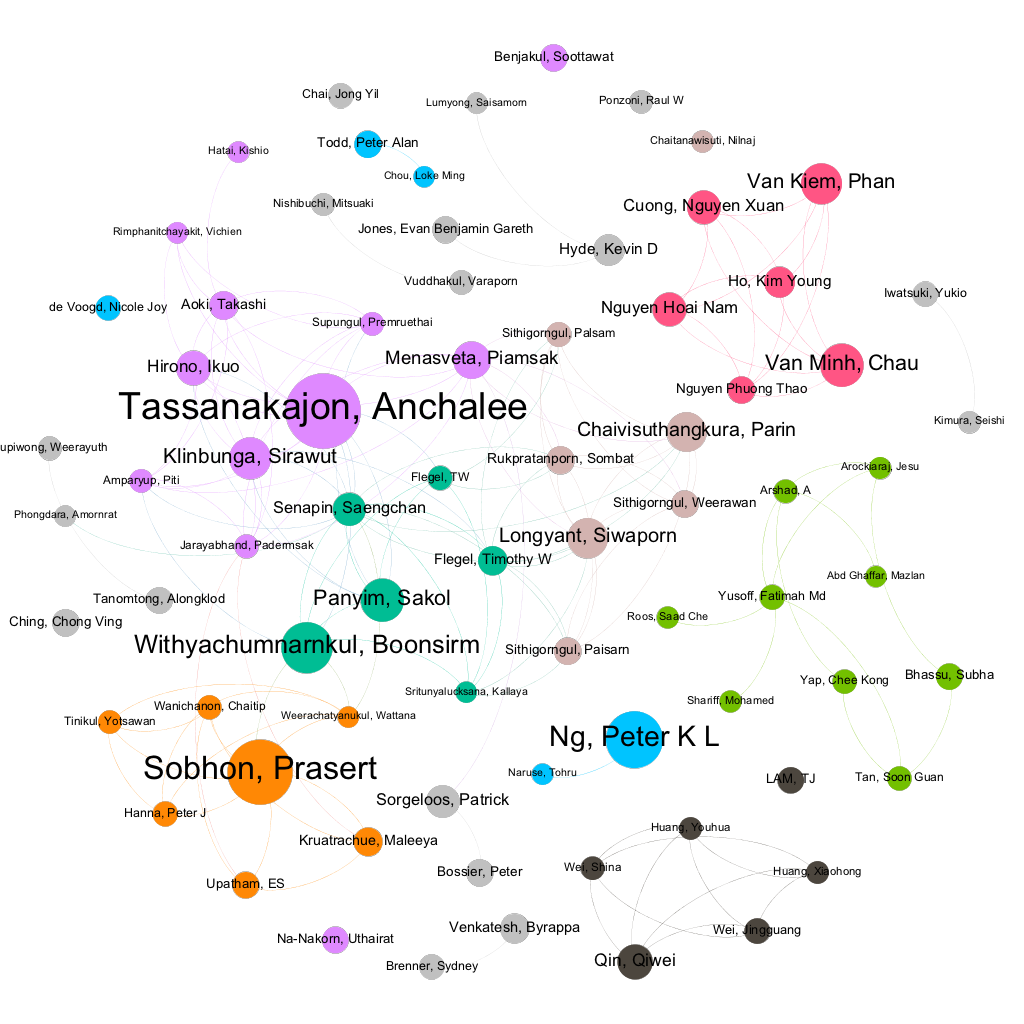
Figure 3.11: Collaboration Networks for Researchers publishing on Marine Genetic Resources in the ASEAN region based on shared publications
We can gain a clearer picture of the relationship between the leading researchers in these clusters and the species involved in their research by placing the researchers and the species that are the target of their research in the same network graph. Figure 3.12 displays the top species, based on the number of records in green and the main researchers in pink.
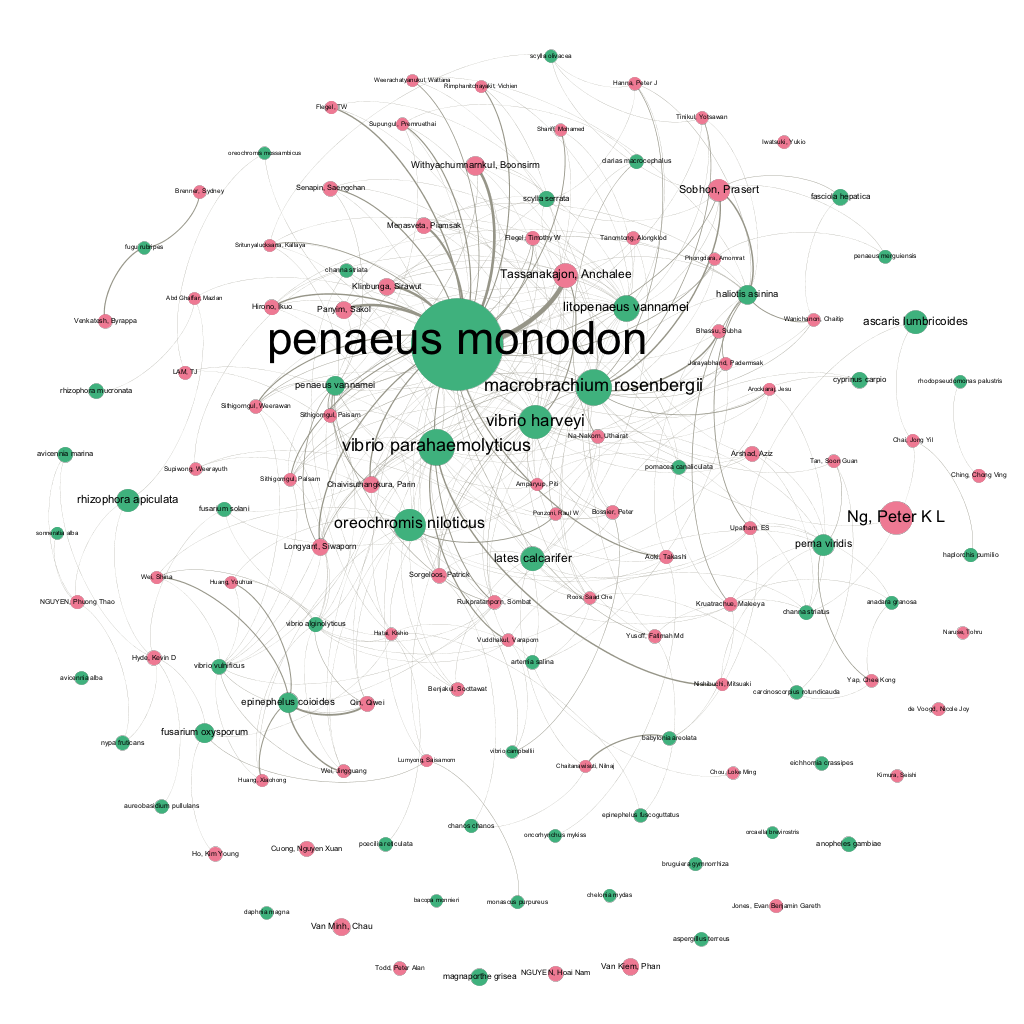
Figure 3.12: Researchers to Species Network in South East Asia
In terms of the overall ranking based on publications Peter Ng Kee Lin is the leading researcher on marine species within the ASEAN region according to our data. However, in Figure 3.12 no prominent connections emerge to species. This reflects the fact that Professor Ng Kee Lin is a biologist and taxonomist who has worked on a wide range of species (notably freshwater and marine crabs) (Cai and Ng 2002; Shih et al. 2007). As such, viewed from a species perspective his research is dispersed across a range of species and therefore not immediately visible.
In contrast Figure 3.12 reveals that Anchalee Tassanakajon at Chulalongkorn University in Thailand is a leading researcher working on Peneaus mondon with links to work on Penaeus vannamei, Litopenaeus vannamei, Haliotis asinina (a large sea snail known as ass’s ear abalone) and the main Vibrio pathogens (Wongteerasupaya et al. 1995; Supungul et al. 2004; Kaewkascholkul et al. 2016). Professor Prasert Sobhon in the Department of Anatomy at Mahidol University shows a similar pattern but with an additional focus on Macrobrachium rosenbergii (the giant freshwater prawn), Fasciola hepatica (parasitic trematodes or liver flukes) and crabs (Scylla olivacea, Scylla serrata) (Meeratana et al. 2006; Duangprom et al. 2017; Preyavichyapugdee et al. 2008). Professor Boonsirm Withyachumnarnkul at the Department of Anatomy at Mahidol University also specialises in Penaeus mondon with a particular focus on selective breeding and disease screening using DNA based techniques (Wongteerasupaya et al. 1995) with recent work focusing on the use of a protein extract from red seaweed to prevent hepatopancreatic necrosis in shrimp (Boonsri et al. 2016). In practice all three researchers while leading distinct groups have collaborated on a number of publications in the past (Wongteerasupaya et al. 1995, 1997; Pongtippatee et al. 2007).
This form of network analysis usefully displays the relationship between researchers and the species they are researching. However, the prominence of aquaculture focused research in the ASEAN research landscape can also, as we saw in the case of Professor Ng Kee Lin, disguise other areas of research.
Figure 3.11 revealed a research cluster focused around Chau Van Minh at the Vietnam Academy of Science and Technology (VAST) in Hanoi whose work, mainly conducted in collaboration with Phan Van Kiem (now at Chungham National University in South Korea), has included an explicit focus on pharmaceutical compounds from Marine Natural Products (Minh, Kiem, and Dang 2017; Quang et al. 2011; N. Thao et al. 2015; N. P. Thao et al. 2015). As we saw in Figure 3.8 this appears to reflect the underlying research investments by funding organisations in Vietnam. We can gain a clearer view of the genera involved in research directed towards chemistry, pharmacology and biotechnology by removing dominant genera such as Peneaus and restricting subject areas to those in chemistry, pharmacology and biotechnology. This data is displayed in Figure 3.13.
Figure 3.13: Pharmaceutical Focused Research for Marine Genetic Resources in the ASEAN region
The top genus emerging in this area are sea snails (gastropods) in the Conus genera with a total of 37 publications in the ASEAN data. Top cited research on Conus includes collaborative research between the University of the Philippines and the University of Utah in the 1990s to identify a Novel Alpha Conotoxin and Omega Conotoxin from Conus striatus Venom, along with other research on a delta conotoxin from Conus gloriamaris (Ramilo et al. 1992; Shon et al. 1994). More recent work at the University of the Philippines with the University of Utah has involved characterisation of the complete mitochondrial genome of Conus tribblei and the structural features of conopeptide genes focusing on gene encoded peptide toxins (Barghi et al. 2015). In Vietnam, members of the Conus genus have also been a focus of research between the University of Nha Trang and CNRS in France concentrating on the identification of novel venom compounds including the use of novel proteomic approaches (Nguyen et al. 2013; Bao Nguyen, Caer, et al. 2014a, 2014b; B. Nguyen et al. 2014)
A second important genus in research directed towards pharmaceuticals and similar products are members of the Channa genus or snakehead fish which includes a range of species found in brackish or freshwater. Research at the University Putra Malaysia has focused on comparative analysis of the protein content of Channa species with a focus on levels of DHA as an explanation for their use in traditional knowledge practices for reducing pain, inflammation and wound healing in Malaysia (Zuraini et al. 2006). More recent research by the University Putra Malaysia has focused on the antidepressant like effects of a lipid extract from Channa striatus and investigation of wound healing (AbdulShukkoor_2016; Baie and Sheikh 2000; Isa et al. 2016).
As this brief summary of research in two genera suggests, while the marine research data is dominated by fisheries and aquaculture related research there is also an important strand of research in Chemistry and Biochemistry focusing on the medical properties of organisms and linking through to using traditional knowledge as a lead for research.
3.0.7 Conclusion
In this section we have mapped and explored the landscape of over 6000 publications on marine genetic resources for the ASEAN region involving 3,685 marine species. The global research network for research on ASEAN marine species has involved approximately 17,736 researchers from nearly 4,000 organisations distributed in 136 countries. As we have seen in this section research activity for marine species in the ASEAN region is growing in the majority of countries. Research activity ranges from basic taxonomic and ecological research to a major concentration of research effort in the aquaculture sector and important concentrations of research in marine natural products directed towards biotechnology and pharmaceuticals. We have also seen that funding for marine research in the ASEAN region is critically dependent on national research funding agencies and an important network of international funding agencies from Japan, China, the United States and Europe who support collaborative research with researchers within and outside the region. In the next section we turn to analysis of the available data on patent activity involving marine species in the ASEAN region with a particular focus on identifying patent activity by researchers from the region.
References
Arnaud-Haond, S., S. Teixeira, S. I. Massa, C. Billot, P. Saenger, G. Coupland, C. M. Duarte, and E. A. Serrão. 2006. “Genetic Structure at Range Edge: Low Diversity and High Inbreeding in Southeast Asian Mangrove (Avicennia Marina) Populations.” Molecular Ecology 15 (12). Wiley-Blackwell: 3515–25. https://doi.org/10.1111/j.1365-294x.2006.02997.x.
Aung, Toe Toe, Maung Maung Than, Ono Katsuhiro, and Mochida Yukira. 2011. “Assessing the Status of Three Mangrove Species Restored by the Local Community in the Cyclone-Affected Area of the Ayeyarwady Delta, Myanmar.” Wetlands Ecology and Management 19 (2). Springer Nature: 195–208. https://doi.org/10.1007/s11273-011-9211-9.
Baie, Saringat Hj, and K.A Sheikh. 2000. “The Wound Healing Properties of Channa Striatus-Cetrimide Cream Tensile Strength Measurement.” Journal of Ethnopharmacology 71 (1-2). Elsevier BV: 93–100. https://doi.org/10.1016/s0378-8741(99)00184-1.
Barghi, Neda, Gisela P. Concepcion, Baldomero M. Olivera, and Arturo O. Lluisma. 2015. “Characterization of the Complete Mitochondrial Genome of Conus Tribblei Walls, 1977.” Mitochondrial DNA Part A 27 (6). Informa UK Limited: 4451–2. https://doi.org/10.3109/19401736.2015.1089566.
Bentsen, Hans B., Ambekar E. Eknath, Marietta S. Palada-de Vera, Jodecel C. Danting, Hernando L. Bolivar, Ruben A. Reyes, Edna E. Dionisio, et al. 1998. “Genetic Improvement of Farmed Tilapias: Growth Performance in a Complete Diallel Cross Experiment with Eight Strains of Oreochromis Niloticus.” Aquaculture 160 (1-2). Elsevier BV: 145–73. https://doi.org/10.1016/s0044-8486(97)00230-5.
Blondel, Vincent D, Jean-Loup Guillaume, Renaud Lambiotte, and Etienne Lefebvre. 2008. “Fast Unfolding of Communities in Large Networks.” Journal of Statistical Mechanics: Theory and Experiment 2008 (10). IOP Publishing: P10008. https://doi.org/10.1088/1742-5468/2008/10/p10008.
Bonami, Jean-Robert, and Joannes Sri Widada. 2011. “Viral Diseases of the Giant Fresh Water Prawn Macrobrachium Rosenbergii: A Review.” Journal of Invertebrate Pathology 106 (1). Elsevier BV: 131–42. https://doi.org/10.1016/j.jip.2010.09.007.
Boonsri, Nantavadee, Tawut Rudtanatip, Boonsirm Withyachumnarnkul, and Kanokpan Wongprasert. 2016. “Protein Extract from Red Seaweed Gracilaria Fisheri Prevents Acute Hepatopancreatic Necrosis Disease (AHPND) Infection in Shrimp.” Journal of Applied Phycology 29 (3). Springer Nature: 1597–1608. https://doi.org/10.1007/s10811-016-0969-2.
Brenner, S., G. Elgar, R. Sanford, A. Macrae, B. Venkatesh, and S. Aparicio. 1993. “Characterization of the Pufferfish (Fugu) Genome as a Compact Model Vertebrate Genome.” Nature 366 (6452). Springer Nature: 265–68. https://doi.org/10.1038/366265a0.
Cai, Yixiong, and Peter K. L. Ng. 2002. “The Freshwater Palaemonid Prawns (Crustacea: Decapoda: Caridea) of Myanmar.” Hydrobiologia 487 (1). Springer Nature: 59–83. https://doi.org/10.1023/a:1022991224381.
De Grave, S., J. Shy, and T. Wowor D. & Page. 2012. “Macrobrachium Rosenbergii.” IUCN. https://doi.org/10.2305/iucn.uk.2013-1.rlts.t197873a2503520.en.
Doi, Masanori, Joebert D. Toledo, Ma Salvacion N. Golez, Miguel de los Santos, and Atsushi Ohno. 1997. “Preliminary Investigation of Feeding Performance of Larvae of Early Red-Spotted Grouper, Epinephelus Coioides, Reared with Mixed Zooplankton.” Hydrobiologia 358 (1/3). Springer Nature: 259–63. https://doi.org/10.1023/a:1003193121532.
Duangprom, Supawadee, Napamanee Kornthong, Saowaros Suwansa-ard, Wittawas Srikawnawan, Charoonroj Chotwiwatthanakun, and Prasert Sobhon. 2017. “Distribution of Crustacean Hyperglycemic Hormones (CHH) in the Mud Crab ( Scylla Olivacea ) and Their Differential Expression Following Serotonin Stimulation.” Aquaculture 468 (February). Elsevier BV: 481–88. https://doi.org/10.1016/j.aquaculture.2016.11.008.
Duke, N., K. Kathiresan, S.G. Salmo III, E.S. Fernando, J.R. Peras, and T. Sukardjo S. & Miyagi. 2008a. “Rhizophora Apiculata.” IUCN: The IUCN Red List of Threatened Species. https://doi.org/10.2305/iucn.uk.2010-2.rlts.t31382a9623321.en.
Duke, N., K. Kathiresan, S.G. Salmo III, J.R. Fernando E.S. andPeras, S. Sukardjo, T. Miyagi, J. Ellison, et al. 2008b. “Avicennia Marina.” IUCN: The IUCN Red List of Threatened Species. https://doi.org/10.2305/iucn.uk.2010-2.rlts.t178828a7619457.en.
Eusebio, Perla S, Relicardo M Coloso, and Roger E P Mamauag. 2004. “Apparent Digestibility of Selected Ingredients in Diets for Juvenile Grouper, Epinephelus Coioides (Hamilton).” Aquaculture Research 35 (13). Wiley-Blackwell: 1261–9. https://doi.org/10.1111/j.1365-2109.2004.01148.x.
Giang, Le Huong, Phan Nguyen Hong, Mai Sy Tuan, and Ko Harada. 2003. “Genetic Variation of Avicennia Marina (Forsk.) Vierh. (Avicenniaceae) in Vietnam Revealed by Microsatellite and AFLP Markers.” Genes & Genetic Systems 78 (6). Genetics Society of Japan: 399–407. https://doi.org/10.1266/ggs.78.399.
Guo, Minglan, Jingguang Wei, Xiaohong Huang, Youhua Huang, and Qiwei Qin. 2012. “Antiviral Effects of Beta-Defensin Derived from Orange-Spotted Grouper (Epinephelus Coioides).” Fish & Shellfish Immunology 32 (5). Elsevier BV: 828–38. https://doi.org/10.1016/j.fsi.2012.02.005.
Hai, Tran Ngoc, and Amararatne Yakupitiyage. 2005. “The Effects of the Decomposition of Mangrove Leaf Litter on Water Quality, Growth and Survival of Black Tiger Shrimp (Penaeus Monodon Fabricius, 1798).” Aquaculture 250 (3-4). Elsevier BV: 700–712. https://doi.org/10.1016/j.aquaculture.2005.04.068.
Hawkins, AJS, RFM Smith, SH Tan, and ZB Yasin. 1998. “Suspension-Feeding Behaviour in Tropical Bivalve Molluscs:Perna Viridis, Crassostrea Belcheri, Crassostrea Iradelei, Saccostrea Cucculata and Pinctada Margarifera.” Marine Ecology Progress Series 166. Inter-Research Science Center: 173–85. https://doi.org/10.3354/meps166173.
Hishamunda, Nathanael, Neil B. Ridler, Pedro Bueno, and Wilfredo G. Yap. 2009. “Commercial Aquaculture in Southeast Asia: Some Policy Lessons.” Food Policy 34 (1). Elsevier BV: 102–7. https://doi.org/10.1016/j.foodpol.2008.06.006.
Hu, Yong-hua, and Li Sun. 2011. “A Bivalent Vibrio Harveyi DNA Vaccine Induces Strong Protection in Japanese Flounder (Paralichthys Olivaceus).” Vaccine 29 (26). Elsevier BV: 4328–33. https://doi.org/10.1016/j.vaccine.2011.04.021.
Isa, Irma Izani Mohamad, Suhaili Abu Bakar, Siti Farah Md Tohid, and Abdul Manan Mat Jais. 2016. “Channa Striatus Cream down-Regulates Tumour Necrosis Factor (TNF)-Alpha Gene Expression and Alleviates Chronic-Like Dermatitis in Mouse Model.” Journal of Ethnopharmacology 194 (December). Elsevier BV: 469–74. https://doi.org/10.1016/j.jep.2016.10.033.
Jain, Ruchy, Orawan Monthakantirat, Parkpoom Tengamnuay, and Wanchai De-Eknamkul. 2014. “Avicequinone c Isolated from Avicennia Marina Exhibits 5a-Reductase-Type 1 Inhibitory Activity Using an Androgenic Alopecia Relevant Cell-Based Assay System.” Molecules 19 (5). MDPI AG: 6809–21. https://doi.org/10.3390/molecules19056809.
Jain, Ruchy, Orawan Monthakantirat, Parkpoom Tengamnuay, and Wanchai De-Eknamkul. 2015. “Identification of a New Plant Extract for Androgenic Alopecia Treatment Using a Non-Radioactive Human Hair Dermal Papilla Cell-Based Assay.” BMC Complementary and Alternative Medicine 16 (1). Springer Nature. https://doi.org/10.1186/s12906-016-1004-5.
Jaree, Phattarunda, Anchalee Tassanakajon, and Kunlaya Somboonwiwat. 2012. “Effect of the Anti-Lipopolysaccharide Factor Isoform 3 (ALFPm3) from Penaeus Monodon on Vibrio Harveyi Cells.” Developmental & Comparative Immunology 38 (4). Elsevier BV: 554–60. https://doi.org/10.1016/j.dci.2012.09.001.
Kaewkascholkul, Napol, Kulwadee Somboonviwat, Shuichi Asakawa, Ikuo Hirono, Anchalee Tassanakajon, and Kunlaya Somboonwiwat. 2016. “Shrimp miRNAs Regulate Innate Immune Response Against White Spot Syndrome Virus Infection.” Developmental & Comparative Immunology 60 (July). Elsevier BV: 191–201. https://doi.org/10.1016/j.dci.2016.03.002.
Kamal, Abu Hena Md. Mostofa, and Graham C. Mair. 2005. “Salinity Tolerance in Superior Genotypes of Tilapia, Oreochromis Niloticus, Oreochromis Mossambicus and Their Hybrids.” Aquaculture 247 (1-4). Elsevier BV: 189–201. https://doi.org/10.1016/j.aquaculture.2005.02.008.
Kangpanich, Chanpim, Jarunan Pratoomyot, Nisa Siranonthana, and Wansuk Senanan. 2016. “Effects of Arachidonic Acid Supplementation in Maturation Diet on Female Reproductive Performance and Larval Quality of Giant River Prawn (Macrobrachium Rosenbergii).” PeerJ 4 (November). PeerJ: e2735. https://doi.org/10.7717/peerj.2735.
Karaket, Thuchapol, and Supawadee Poompuang. 2012. “CERVUS Vs. COLONY for Successful Parentage and Sibship Determinations in Freshwater Prawn Macrobrachium Rosenbergii de Man.” Aquaculture 324-325 (January). Elsevier BV: 307–11. https://doi.org/10.1016/j.aquaculture.2011.10.045.
Maneechote, Nipat, Boon-ek Yingyongnarongkul, Apichart Suksamran, and Saisamorn Lumyong. 2016. “Inhibition ofVibriospp. By 2-Hydroxyethyl-11-Hydroxyhexadec-9-Enoate of Marine CyanobacteriumLeptolyngbyasp. LT19.” Aquaculture Research 48 (5). Wiley: 2088–95. https://doi.org/10.1111/are.13043.
Marasigan, Arnulfo N, Shigeru Sato, Yasuo Fukuyo, and Masaaki Kodama. 2001. “Accumulation of a High Level of Diarrhetic Shellfish Toxins in the Green Mussel Perna Viridis During a Bloom of Dinophysis Caudata and Dinophysis Miles in Sapian Bay, Panay Island, the Philippines.” Fisheries Science 67 (5). Springer Nature: 994–96. https://doi.org/10.1046/j.1444-2906.2001.00353.x.
Meeratana, Prasert, Boonsirm Withyachumnarnkul, Praneet Damrongphol, Kanokphan Wongprasert, Anchalee Suseangtham, and Prasert Sobhon. 2006. “Serotonin Induces Ovarian Maturation in Giant Freshwater Prawn Broodstock, Macrobrachium Rosenbergii de Man.” Aquaculture 260 (1-4). Elsevier BV: 315–25. https://doi.org/10.1016/j.aquaculture.2006.06.010.
Minh, Chau Van, Phan Van Kiem, and Nguyen Hai Dang. 2017. “Marine Natural Products and Their Potential Application in the Future.” ASEAN Journal on Science and Technology for Development 22 (4). UGM Press: 297. https://doi.org/10.29037/ajstd.167.
Mohd-Yusof, N. Y., O. Monroig, A. Mohd-Adnan, K.-L. Wan, and D. R. Tocher. 2010. “Investigation of Highly Unsaturated Fatty Acid Metabolism in the Asian Sea Bass, Lates Calcarifer.” Fish Physiology and Biochemistry 36 (4). Springer Nature: 827–43. https://doi.org/10.1007/s10695-010-9409-4.
Montresor, Antonio, Dai Tran Cong, Tuan Le Anh, Alexander Ehrhardt, Elisa Mondadori, Thach Dang Thi, Thuan Le Khanh, Marco Albonico, and Kevin L. Palmer. 2007. “Cost Containment in a School Deworming Programme Targeting over 2.7 Million Children in Vietnam.” Transactions of the Royal Society of Tropical Medicine and Hygiene 101 (5). Oxford University Press (OUP): 461–64. https://doi.org/10.1016/j.trstmh.2006.07.008.
Nair, G. B., T. Ramamurthy, S. K. Bhattacharya, B. Dutta, Y. Takeda, and D. A. Sack. 2007. “Global Dissemination of Vibrio Parahaemolyticus Serotype O3:K6 and Its Serovariants.” Clinical Microbiology Reviews 20 (1). American Society for Microbiology: 39–48. https://doi.org/10.1128/cmr.00025-06.
Nguyen, Bao, Jean-Pierre Le Caer, Romulo Aráoz, Robert Thai, Hung Lamthanh, Evelyne Benoit, and Jordi Molgó. 2014a. “Isolation, Purification and Functional Characterization of Alpha-BnIA from Conus Bandanus Venom.” Toxicon 91 (December). Elsevier BV: 155–63. https://doi.org/10.1016/j.toxicon.2014.10.006.
Nguyen, Bao, Jean-Pierre Caer, Gilles Mourier, Robert Thai, Hung Lamthanh, Denis Servent, Evelyne Benoit, and Jordi Molgó. 2014b. “Characterization of a Novel Conus Bandanus Conopeptide Belonging to the M-Superfamily Containing Bromotryptophan.” Marine Drugs 12 (12). MDPI AG: 3449–65. https://doi.org/10.3390/md12063449.
Nguyen, Bao, Jordi Molgó, Hung Lamthanh, Evelyne Benoit, Thi An Khuc, Dang Nghia Ngo, Ngoc Thach Nguyen, Paul Millares, and Jean-Pierre Le Caer. 2013. “High Accuracy Mass Spectrometry Comparison of Conus Bandanus and Conus Marmoreus Venoms from the South Central Coast of Vietnam.” Toxicon 75 (December). Elsevier BV: 148–59. https://doi.org/10.1016/j.toxicon.2013.06.005.
Nguyen, B., J.-P. Le Caer, H. Lamthanh, G. Mourier, D. Servent, R. Aráoz, E. Benoit, and J. Molgó. 2014. “41. A Novel Bromotryptophan Gamma-Carboxyglutamic Acid-Containing-Conotoxin from the Venom of Conus Bandanus.” Toxicon 91 (December). Elsevier BV: 181. https://doi.org/10.1016/j.toxicon.2014.08.049.
Nguyen, H.V., D. Caruso, M. Lebrun, N.T. Nguyen, T.T. Trinh, J.-C. Meile, S. Chu-Ky, and S. Sarter. 2016. “Antibacterial Activity ofLitsea Cubeba(Lauraceae, May Chang) and Its Effects on the Biological Response of Common carpCyprinus Carpiochallenged withAeromonas Hydrophila.” Journal of Applied Microbiology 121 (2). Wiley-Blackwell: 341–51. https://doi.org/10.1111/jam.13160.
Nimrat, Subuntith, Traimat Boonthai, and Verapong Vuthiphandchai. 2011. “Effects of Probiotic Forms, Compositions of and Mode of Probiotic Administration on Rearing of Pacific White Shrimp (Litopenaeus Vannamei) Larvae and Postlarvae.” Animal Feed Science and Technology 169 (3-4). Elsevier BV: 244–58. https://doi.org/10.1016/j.anifeedsci.2011.07.003.
Nimrat, Subuntith, Sopon Siriboonlamom, Shicui Zhang, Yuyan Xu, and Verapong Vuthiphandchai. 2006. “Chilled Storage of White Shrimp (Litopenaeus Vannamei) Spermatophores.” Aquaculture 261 (3). Elsevier BV: 944–51. https://doi.org/10.1016/j.aquaculture.2006.08.018.
Pongtippatee, Pattira, Rapeepan Vanichviriyakit, Jittipan Chavadej, Pornthep Plodpai, Boonyarath Pratoomchart, Prasert Sobhon, and Boonsirm Withyachumnarnkul. 2007. “Acrosome Reaction in the Sperm of the Black Tiger Shrimp Penaeus Monodon (Decapoda, Penaeidae).” Aquaculture Research 38 (15). Wiley-Blackwell: 1635–44. https://doi.org/10.1111/j.1365-2109.2007.01824.x.
Ponprateep, Sirikwan, Kunlaya Somboonwiwat, and Anchalee Tassanakajon. 2009. “Recombinant Anti-Lipopolysaccharide Factor Isoform 3 and the Prevention of Vibriosis in the Black Tiger Shrimp, Penaeus Monodon.” Aquaculture 289 (3-4). Elsevier BV: 219–24. https://doi.org/10.1016/j.aquaculture.2009.01.026.
Ponprateep, Sirikwan, Anchalee Tassanakajon, and Vichien Rimphanitchayakit. 2011. “A Kazal Type Serine Proteinase SPIPm2 from the Black Tiger Shrimp Penaeus Monodon Is Capable of Neutralization and Protection of Hemocytes from the White Spot Syndrome Virus.” Fish & Shellfish Immunology 31 (6). Elsevier BV: 1179–85. https://doi.org/10.1016/j.fsi.2011.10.013.
Preyavichyapugdee, Narin, Somphong Sahaphong, Suda Riengrojpitak, Rudi Grams, Vitoon Viyanant, and Prasert Sobhon. 2008. “Fasciola Gigantica and Schistosoma Mansoni: Vaccine Potential of Recombinant Glutathione S-Transferase (rFgGST26) Against Infections in Mice.” Experimental Parasitology 119 (2). Elsevier BV: 229–37. https://doi.org/10.1016/j.exppara.2008.01.014.
Qin, Q.W., T.H. Wu, T.L. Jia, A. Hegde, and R.Q. Zhang. 2006. “Development and Characterization of a New Tropical Marine Fish Cell Line from Grouper, Epinephelus Coioides Susceptible to Iridovirus and Nodavirus.” Journal of Virological Methods 131 (1). Elsevier BV: 58–64. https://doi.org/10.1016/j.jviromet.2005.07.009.
Quang, Tran Hong, Tran Thu Ha, Chau Van Minh, Phan Van Kiem, Hoang Thanh Huong, Nguyen Thi Thanh Ngan, Nguyen Xuan Nhiem, et al. 2011. “Cytotoxic and Anti-Inflammatory Cembranoids from the Vietnamese Soft Coral Lobophytum Laevigatum.” Bioorganic & Medicinal Chemistry 19 (8). Elsevier BV: 2625–32. https://doi.org/10.1016/j.bmc.2011.03.009.
Rahman, Mokhlasur, N. A. Bhuiyan, I. Kuhn, T. Ramamurthy, M. Rahman, R. Mollby, and G. Balakrish Nair. 2006. “Biochemical Fingerprinting of Vibrio Parahaemolyticus by the PhenePlate System: Comparison Between Pandemic and Non-Pandemic Serotypes.” Epidemiology and Infection 134 (05). Cambridge University Press (CUP): 985. https://doi.org/10.1017/s0950268806006017.
Ramilo, Cecilia A., Glenn C. Zafaralla, Laszlo Nadasdi, Lance G. Hammerland, Doju Yoshikami, William R. Gray, Ramasharma Kristipati, J. Ramachandran, and George Miljanich. 1992. “Novel .Alpha.- and .Omega.-conotoxins and Conus Striatus Venom.” Biochemistry 31 (41). American Chemical Society (ACS): 9919–26. https://doi.org/10.1021/bi00156a009.
Shadrin, A. M., and D. S. Pavlov. 2015. “Embryonic and Larval Development of the Asian Seabass Lates Calcarifer (Pisces: Perciformes: Latidae) Under Thermostatically Controlled Conditions.” Biology Bulletin 42 (4). Pleiades Publishing Ltd: 334–46. https://doi.org/10.1134/s1062359015040123.
Shansudin, Lokman, M. Yusof, A. Azis, and Y. Shukri. 1997. “The Potential of Certain Indigenous Copepod Species as Live Food for Commercial Fish Larval Rearing.” Aquaculture 151 (1-4). Elsevier BV: 351–56. https://doi.org/10.1016/s0044-8486(96)01490-1.
Shapawi, Rossita, and Anes Ateqah Zamry. 2015. “Response of Asian Seabass,Lates Calcariferjuvenile Fed with Different Seaweed-Based Diets.” Journal of Applied Animal Research 44 (1). Informa UK Limited: 121–25. https://doi.org/10.1080/09712119.2015.1021805.
Shih, Hsi-Te, Peter K. L. Ng, Christoph D. Schubart, and Hsueh-Wen Chang. 2007. “Phylogeny and Phylogeography of the Genus Geothelphusa (Crustacea: Decapoda, Brachyura, Potamidae) in Southwestern Taiwan Based on Two Mitochondrial Genes.” Zoological Science 24 (1). Zoological Society of Japan: 57–66. https://doi.org/10.2108/zsj.24.57.
Shon, Ki-Joon, Arik Hasson, Micha E. Spira, Lourdes J. Cruz, William R. Gray, and Baldomero M. Olivera. 1994.“Delta.-Conotoxin GmVIA, a Novel Peptide from the Venom of Conus Gloriamaris.” Biochemistry 33 (38). American Chemical Society (ACS): 11420–5. https://doi.org/10.1021/bi00204a003.
Silva, Veronica Arns da, Fernando L. dos Santos, Suely S. Bezerra, Virginia F. Pedrosa, Paulo de P. Mendes, and Emiko S. Mendes. 2010. “A Multi-Season Survey for Infectious Myonecrosis in Farmed Shrimp, Litopenaeus Vannamei, in Pernambuco, Brazil.” Journal of Invertebrate Pathology 104 (3). Elsevier BV: 161–65. https://doi.org/10.1016/j.jip.2010.03.001.
Sivasothy, Yasodha, Shaida Fariza Sulaiman, Kheng Leong Ooi, Halijah Ibrahim, and Khalijah Awang. 2013. “Antioxidant and Antibacterial Activities of Flavonoids and Curcuminoids from Zingiber Spectabile Griff.” Food Control 30 (2). Elsevier BV: 714–20. https://doi.org/10.1016/j.foodcont.2012.09.012.
Supungul, P, S Klinbunga, R Pichyangkura, I Hirono, T Aoki, and A Tassanakajon. 2004. “Antimicrobial Peptides Discovered in the Black Tiger Shrimp Penaeus Monodon Using the EST Approach.” Diseases of Aquatic Organisms 61. Inter-Research Science Center: 123–35. https://doi.org/10.3354/dao061123.
Tan, Kar Soon, and Julian Ransangan. 2016. “Feeding Behaviour of Green Mussels,Perna Viridisfarmed in Marudu Bay, Malaysia.” Aquaculture Research 48 (3). Wiley-Blackwell: 1216–31. https://doi.org/10.1111/are.12963.
Thanh, Hai Nguyen, Qigen Liu, Liangjie Zhao, Hong Zhang, and Jun Liu. 2015. “Genetic Diversity of the Cultured Giant Freshwater Prawn (Macrobrachium Rosenbergii) in China Based on Microsatellite Markers.” Biochemical Systematics and Ecology 59 (April). Elsevier BV: 144–54. https://doi.org/10.1016/j.bse.2014.12.023.
Thanh, Nguyen Minh, Nguyen Hong Nguyen, Raul W. Ponzoni, Nguyen Thanh Vu, Andrew C. Barnes, and Peter B. Mather. 2010. “Estimates of Strain Additive and Non-Additive Genetic Effects for Growth Traits in a Diallel Cross of Three Strains of Giant Freshwater Prawn (Macrobrachium Rosenbergii) in Vietnam.” Aquaculture 299 (1-4). Elsevier BV: 30–36. https://doi.org/10.1016/j.aquaculture.2009.12.011.
Thao, Nguyen, Bui Luyen, Jung Koo, Sohyun Kim, Young Koh, Nguyen Cuong, Nguyen Nam, Phan Van Kiem, Young Kim, and Chau Van Minh. 2015. “Anti-Inflammatory Components of the Vietnamese Starfish Protoreaster Nodosus.” Biological Research 48 (1). Springer Nature: 12. https://doi.org/10.1186/s40659-015-0002-2.
Thao, Nguyen Phuong, Bui Thi Thuy Luyen, Eun Ji Kim, Jung Il Kang, Hee Kyoung Kang, Nguyen Xuan Cuong, Nguyen Hoai Nam, Phan Van Kiem, Chau Van Minh, and Young Ho Kim. 2015. “Steroidal Constituents from the Edible Sea UrchinDiadema savignyiMichelin Induce Apoptosis in Human Cancer Cells.” Journal of Medicinal Food 18 (1). Mary Ann Liebert Inc: 45–53. https://doi.org/10.1089/jmf.2013.3105.
Tinh, Tran Huu, Taiyeebah Nuidate, Varaporn Vuddhakul, and Channarong Rodkhum. 2016. “Antibacterial Activity of Pyrogallol, a Polyphenol Compound Against Vibrio Parahaemolyticus Isolated from the Central Region of Thailand.” Procedia Chemistry 18. Elsevier BV: 162–68. https://doi.org/10.1016/j.proche.2016.01.025.
Vaiphasa, C., W. F. de Boer, A. K. Skidmore, S. Panitchart, T. Vaiphasa, N. Bamrongrugsa, and P. Santitamnont. 2007. “Impact of Solid Shrimp Pond Waste Materials on Mangrove Growth and Mortality: A Case Study from Pak Phanang, Thailand.” Hydrobiologia 591 (1). Springer Nature: 47–57. https://doi.org/10.1007/s10750-007-0783-6.
Vromant, Nico, Cao Quoc Nam, and Frans Ollevier. 2002. “Growth Performance of Barbodes Gonionotus (Bleeker) in Intensively Cultivated Rice Fields.” Aquaculture 212 (1-4). Elsevier BV: 167–78. https://doi.org/10.1016/s0044-8486(02)00005-4.
Wongteerasupaya, C, W Tongcheua, V Boonsaeng, S Panyim, A Tassanakajon, B Withyachumnarnkul, and TW Flegel. 1997. “Detection of Yellow-Head Virus (YHV) of Penaeus Monodon by RT-PCR Amplification.” Diseases of Aquatic Organisms 31. Inter-Research Science Center: 181–86. https://doi.org/10.3354/dao031181.
Wongteerasupaya, C, JE Vickers, S Sriurairatana, GL Nash, A Akarajamorn, V Boonsaeng, S Panyim, A Tassanakajon, B Withyachumnarnkul, and TW Flegel. 1995. “A Non-Occluded, Systemic Baculovirus That Occurs in Cells of Ectodermal and Mesodermal Origin and Causes High Mortality in the Black Tiger Prawn Penaeus Monodon.” Diseases of Aquatic Organisms 21. Inter-Research Science Center: 69–77. https://doi.org/10.3354/dao021069.
Yap, C.K, A Ismail, and S.G Tan. 2004. “Heavy Metal (Cd, Cu, Pb and Zn) Concentrations in the Green-Lipped Mussel Perna Viridis (Linnaeus) Collected from Some Wild and Aquacultural Sites in the West Coast of Peninsular Malaysia.” Food Chemistry 84 (4). Elsevier BV: 569–75. https://doi.org/10.1016/s0308-8146(03)00280-2.
Yap, C.K., A. Ismail, S.G. Tan, and H. Omar. 2002. “Correlations Between Speciation of Cd, Cu, Pb and Zn in Sediment and Their Concentrations in Total Soft Tissue of Green-Lipped Mussel Perna Viridis from the West Coast of Peninsular Malaysia.” Environment International 28 (1-2). Elsevier BV: 117–26. https://doi.org/10.1016/s0160-4120(02)00015-6.
Yap, C.K., A. Ismail, S.G. Tan, and I. Abdul Rahim. 2003. “Can the Shell of the Green-Lipped Mussel Perna Viridis from the West Coast of Peninsular Malaysia Be a Potential Biomonitoring Material for Cd, Pb and Zn?” Estuarine, Coastal and Shelf Science 57 (4). Elsevier BV: 623–30. https://doi.org/10.1016/s0272-7714(02)00401-8.
Ye, Yingying, Jiji Li, and Changwen Wu. 2015. “Genetic Diversity and Population Connectivity of the Asian Green Mussel Perna Viridis in South China Sea, Inferred from Mitochondria DNA Markers.” Biochemical Systematics and Ecology 61 (August). Elsevier BV: 470–76. https://doi.org/10.1016/j.bse.2015.07.009.
Zhila, Hemati, Hossain Mahmood, and M. Z. Rozainah. 2013. “Biodiversity and Biomass of a Natural and Degraded Mangrove Forest of Peninsular Malaysia.” Environmental Earth Sciences 71 (11). Springer Nature: 4629–35. https://doi.org/10.1007/s12665-013-2853-6.
Zhou, Jing-Geng, Jing-Guang Wei, Dan Xu, Hua-Chun Cui, Yang Yan, Zheng-Liang Ou-Yang, Xiao-Hong Huang, You-Hua Huang, and Qi-Wei Qin. 2011. “Molecular Cloning and Characterization of Two Novel Hepcidins from Orange-Spotted Grouper, Epinephelus Coioides.” Fish & Shellfish Immunology 30 (2). Elsevier BV: 559–68. https://doi.org/10.1016/j.fsi.2010.11.021.
Zuraini, A., M.N. Somchit, M.H. Solihah, Y.M. Goh, A.K. Arifah, M.S. Zakaria, N. Somchit, M.A. Rajion, Z.A. Zakaria, and A.M. Mat Jais. 2006. “Fatty Acid and Amino Acid Composition of Three Local Malaysian Channa Spp. Fish.” Food Chemistry 97 (4). Elsevier BV: 674–78. https://doi.org/10.1016/j.foodchem.2005.04.031.
Subject Areas refer to Web of Science Subject Categories which seek to describe the subject area of journals where articles are published. A single journal may fall into more than one category and are used here as a proxy for summarising research subjects↩
Source: IUCN Red List at http://www.iucnredlist.org/details/197873/0↩
Source: Encyclopaedia of Life at http://eol.org/pages/356343/data?toc_id=4#1448↩
Demersal fish are bottom feeders in what is known as the demersal zone↩
Source: Fishbase http://www.fishbase.org/summary/6465↩